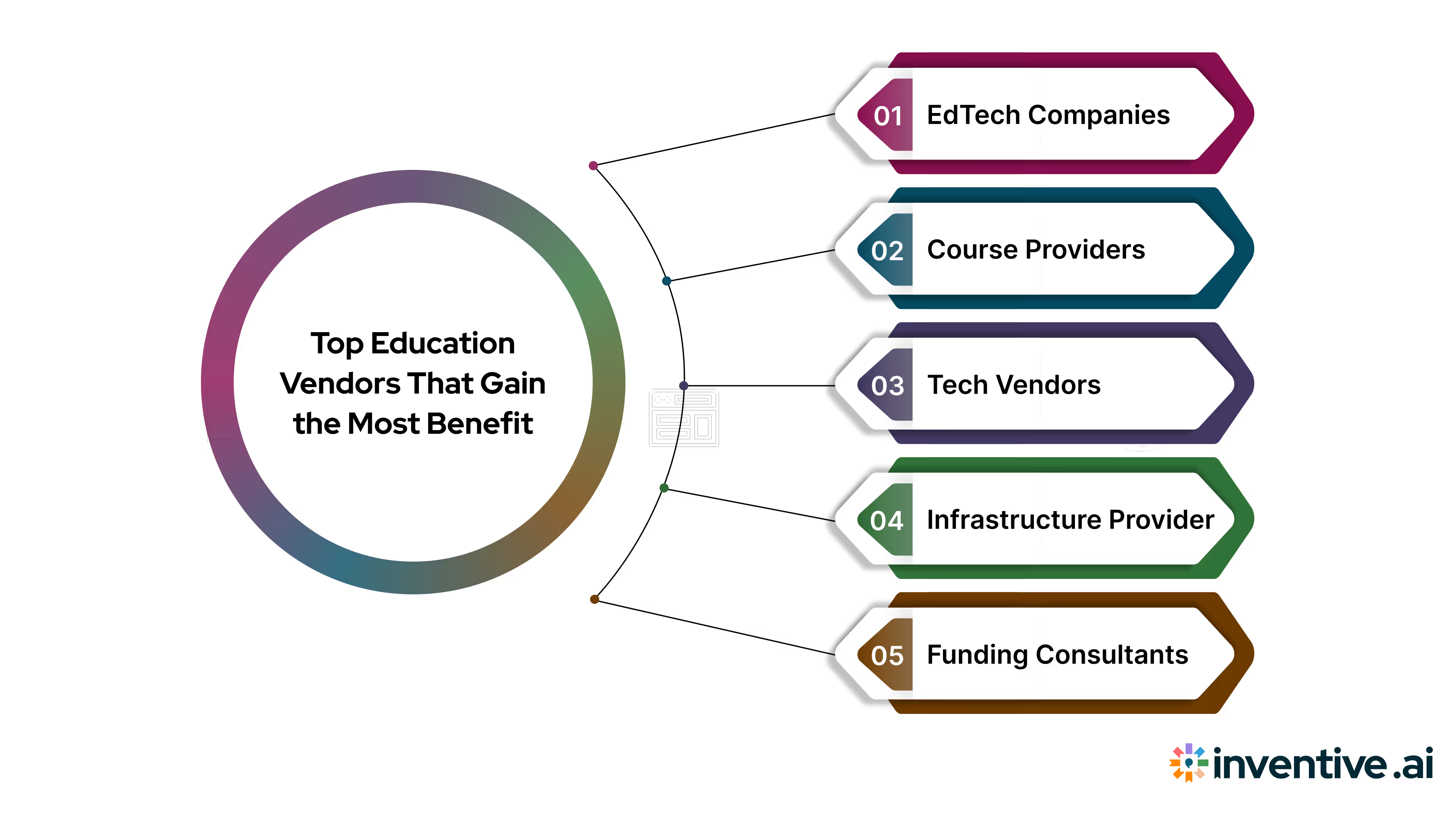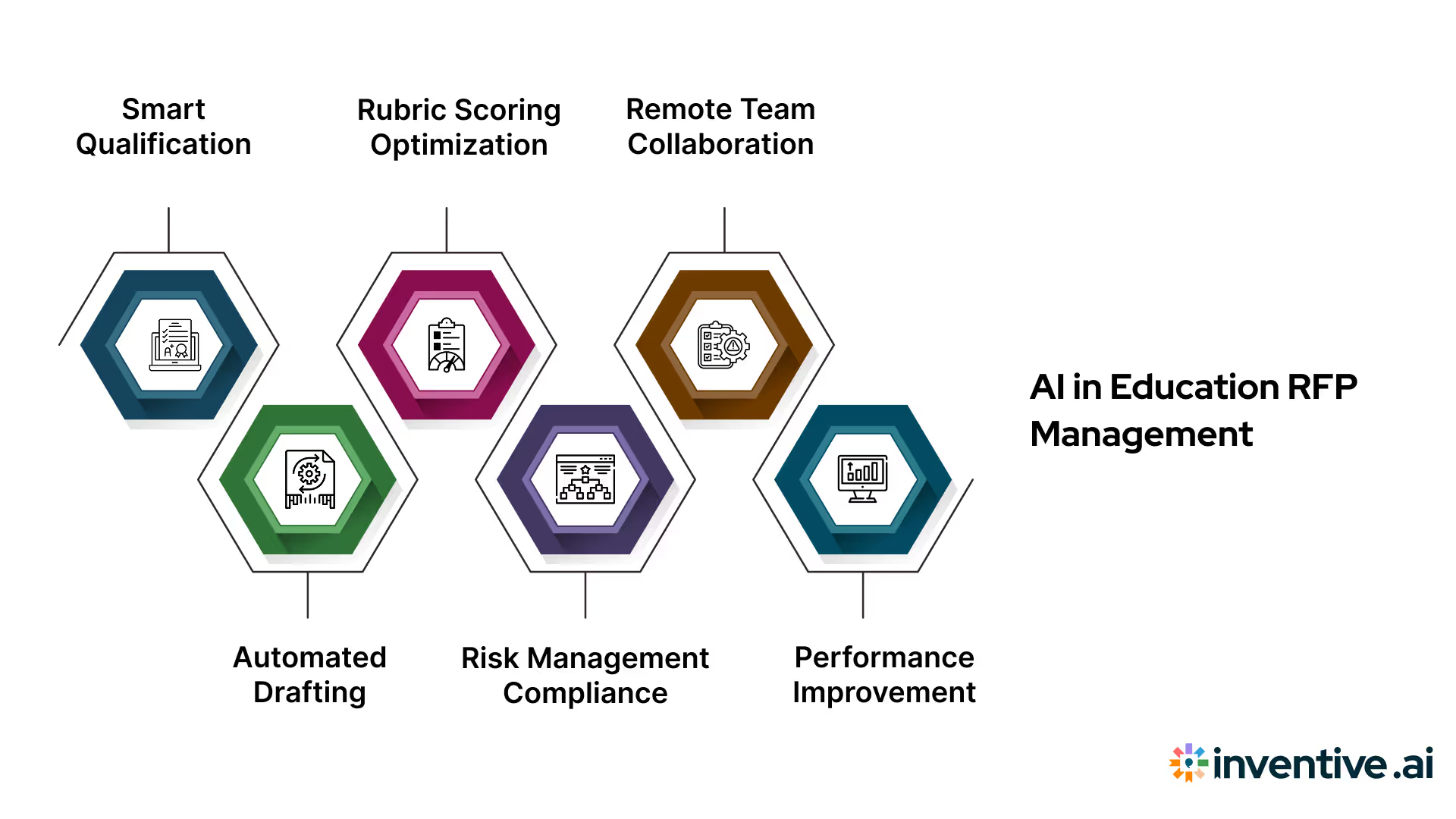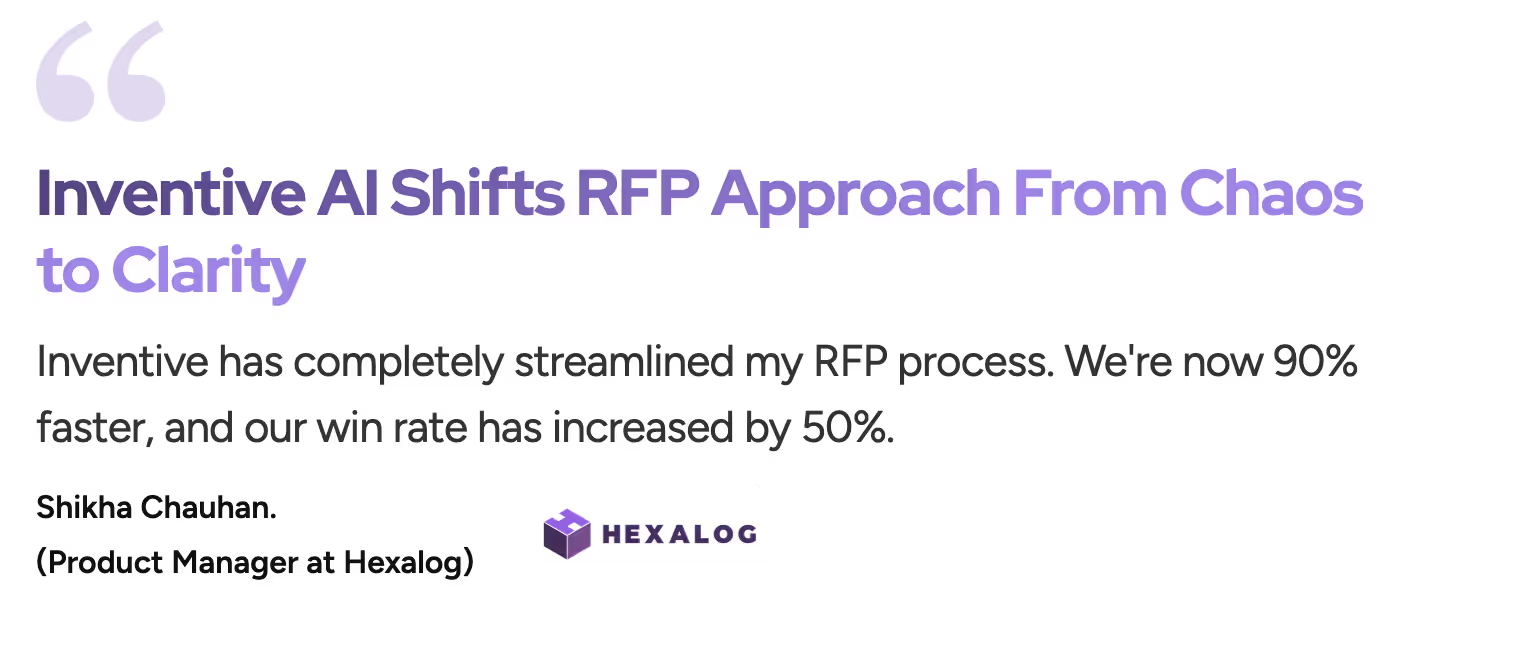Top Strategies for Education RFP Management
Navigate top education RFP management challenges. Present clear timelines, budget, and scope in your RFPs. Boost outcomes—click for strategies!

The education sector is experiencing a surge in Requests for Proposals (RFPs) from school districts, universities, and government-backed programs, each with technical requirements, and multi-stakeholder evaluation criteria. Whether it’s a K–12 district upgrading its learning management system or a university investing in cybersecurity, these RFPs are complex and competitive.
For vendors, this rise in opportunities comes with challenges: tight deadlines, rigid submission formats, and heightened competition from other providers offering similar solutions. In today’s environment, having a great product or service is no longer enough. Success now hinges on the ability to craft responsive, that address the exact scoring criteria evaluators are using.
This makes having a strategic RFP management plan essential to stand out and win at scale. In this blog, we’ll break down proven strategies to help education vendors go through complex RFPs, streamline their response process, and consistently win more bids with confidence.
Understanding the Complexity of Education RFPs
Education RFPs aren’t just long, they’re layered with regulatory, administrative, and technical expectations that vary across districts, states, and institutions. Unlike commercial bids, education RFPs often follow rigid formats and are subject to public transparency standards, making every response both a competitive proposal and a public record. It is believed that 20% to 30% of public sector RFP rejections are due to formatting errors, missing documentation, or procedural non-compliance.
Most education RFPs require several important documents such as curriculum alignment papers, detailed schedules for implementation, plans for staff training, and evidence of following regulations like FERPA, COPPA, or Title I funding rules. These aren’t simply boxes to tick but critical requirements needing careful attention and proper documentation.
The complexity increases when you consider the number of stakeholders involved. You’re not just writing for a single decision-maker. Education RFP responses are reviewed by committees made up of IT teams, academic coordinators, finance officers, and procurement specialists, all with different priorities and review lenses. To win, your response must speak to every one of them, clearly.
Now that we understand what sets education RFPs apart, let’s explore which vendors are best positioned to benefit from improved RFP processes.
Types of Education Vendors That Benefit Most

Educational institutions don’t issue RFPs just to compare vendor pricing, they do it to solve urgent systemic problems, modernize outdated processes, and meet mandates tied to funding, compliance, and equity. Every RFP reflects institutional pressures — the need to improve learning outcomes, close digital gaps, ensure regulatory compliance, and justify taxpayer or grant-based spending through transparent procurement.
Understanding these motivations gives vendors an edge, because winning isn’t just about ticking boxes; it’s about demonstrating value aligned with institutional priorities.
Here are the key vendor types best positioned to benefit from AI-enabled RFP management, and the institutional needs driving demand in each area:
EdTech Companies
Platforms offering Learning Management Systems (LMS), assessment tools, virtual classrooms, and tutoring solutions are in high demand as schools prioritize digital equity, hybrid learning, and measurable student progress. RFPs in this space often focus on tools that integrate seamlessly with existing platforms, support district-wide rollouts, and meet accessibility standards.
Institutional Drivers:
- Pressure to close learning gaps post-pandemic
- Demand for remote-ready infrastructure
- Mandates for accessible, scalable learning solutions
Curriculum & Content Providers
Vendors developing academic content, lesson plans, and professional development programs must align with state standards, support differentiated instruction, and demonstrate efficacy in boosting outcomes. RFPs require evidence-based methodologies, teacher training components, and compatibility with existing district goals.
Institutional Drivers:
- Curriculum alignment with evolving state frameworks
- Equity in content delivery across diverse populations
- ROI on student outcomes and instructional quality
IT & Cybersecurity Vendors
From student data privacy to campus connectivity, IT vendors must meet strict compliance frameworks like FERPA and COPPA. Institutions issue RFPs to safeguard digital assets, modernize infrastructure, and manage multi-device environments across campuses.
Institutional Drivers:
- Regulatory mandates on data protection and digital safety
- IT modernization for increasingly digital classrooms
- Risk mitigation and audit-readiness
Facilities & Infrastructure Firms
Vendors handling school construction, HVAC systems, or digital signage often deal with district-level procurement and public bid transparency laws. A streamlined proposal process ensures timely, compliant submissions.
Institutional Drivers:
- Safe and sustainable learning environments
- Transparent use of capital improvement budgets
- Compliance with public works and bidding regulations
Grants & Program Consultants
These consultants assist districts in applying for and implementing programs funded by Title I, ESSER, and other federal initiatives. RFPs typically require documentation of past success, clear training and reporting plans, and alignment with federal spending timelines.
Institutional Drivers:
- Maximizing federal and state funding utilization
- Achieving measurable outcomes tied to grants
- Ensuring full compliance and audit readiness
No matter your specialization, if you're submitting proposals to school districts, education boards, or public universities, having a repeatable and intelligent RFP response process gives you a significant competitive edge.
Regardless of the solution you offer, tracking the right performance metrics is crucial to refining your RFP strategy over time. Let’s look at the most valuable KPIs to monitor.
Smarter Strategies and Metrics to Win More Education RFPs
Winning education RFPs is about responding smarter. To stand out in a competitive, compliance-heavy environment, vendors must combine repeatable strategies with the right performance insights.
Here's how to build a high-impact RFP approach, and what to track to keep improving.
1. Start With a Structured Go/No-Go Framework
Every RFP is not worth pursuing. Without a clear qualification process, your team might spend valuable time on proposals that are unlikely to convert. A structured go/no-go framework helps you evaluate each RFP against specific criteria, such as product fit, available budget, submission deadlines, and alignment with your existing capabilities.
Track win rate by institution type.Don’t just measure how many RFPs you win. Break your win rates down by segment, K–12, charter schools, public universities, or state grant programs, to identify where your efforts are most successful. This helps prioritize future opportunities that are more likely to deliver returns.
2. Build and Maintain an AI-Powered Proposal Library
Education RFPs often ask the same questions—implementation plans, support models, compliance with accessibility standards, and so on. An AI-powered proposal content library allows you to store winning responses, case studies, and templates in a single location. Over time, your library becomes a valuable asset that reduces repetitive work and improves response speed.
Track content reuse ratio. Measure how much content is reused from your library versus drafted from scratch. A higher reuse rate indicates a mature and efficient content management process.
3. Align Your Proposal With Evaluation Rubrics
Most education RFPs come with a scoring rubric that details how proposals will be evaluated, by factors like cost, implementation ease, technical capabilities, and long-term value. Your proposal should directly reflect these criteria.
Example: If “training and support” is a high-priority evaluation factor, include a clear onboarding plan with timelines, roles, and previous success stories. Using the same language evaluators use helps make your submission easier to score and more aligned with their expectations.
Keep track of feedback trends from reviewers. When schools or institutions offer reviewer feedback, analyze the recurring comments. Look for patterns in rejections, such as “unclear rollout timelines” or “incomplete compliance forms,” and address them in future responses.
4. Automate Compliance and Document Validation
Education RFPs are strict—miss a document, skip a certification, or use the wrong format, and your submission may be rejected. Automating compliance workflows ensures every requirement is accounted for, from licensing forms to deadline reminders.
Track how many proposals pass internal quality checks versus those requiring rework. This helps identify which areas—document formatting, attachments, or certifications, need better process control.
5. Centralize Collaboration Across Teams
Responding to education RFPs involves multiple contributors—legal, sales, implementation, customer success, finance, and more. Managing this collaboration over email or shared drives often results in version conflicts, missed deadlines, or communication gaps.
With a centralized RFP workspace, your team can assign tasks, leave comments, track real-time progress, and ensure everyone works from the latest version.
Keep track of Average response time. Measure how long it takes your team from RFP qualification to final submission. If the time is consistently long, it may indicate bottlenecks in collaboration or review cycles.
6. Scale RFP Volume Without Increasing Headcount
Many vendors face a high volume of similar RFPs, especially when targeting multiple school districts or applying for recurring state-funded grants. Manually handling every proposal is time-consuming and resource-heavy.
Using automation tools to generate first drafts, pre-fill standard sections, and suggest industry-specific content allows your team to respond to more RFPs without adding headcount.
Keep track of proposal volume vs. team capacity. See how many RFPs your team can manage per quarter compared to available resources. This helps assess efficiency and identify when automation tools are freeing up your team's time.
7. Continuously Monitor and Optimize Performance
Even a great proposal strategy can benefit from fine-tuning. Regularly tracking your proposal metrics allows you to uncover process issues, identify content gaps, and understand what’s driving wins or losses.
Modern RFP platforms offer dashboards and reporting tools that make it easy to track KPIs and adjust strategies in real time.
Keep track of win rate, content effectiveness and time to completion. These high-level metrics help you identify what’s working and what needs improvement across your entire RFP response operation.
These metrics not only highlight what’s working, they also point to areas for process improvement. Next, let’s dive into actionable strategies you can implement today.
Strategy is just one side of the coin. The right tools can amplify these efforts significantly. Let’s explore how AI tools make managing education RFPs faster, smarter, and more scalable.
RFP Compliance & Proposal Readiness Checklist for Education Vendors
Before submitting your next RFP response to a K–12 district or higher education institution, run through this checklist to ensure accuracy, compliance, and strategic alignment.
Strategic Fit
- Opportunity qualified through Go/No-Go analysis
- Aligned with your core offering and past wins
- Realistic budget, timeline, and institutional fit
Proposal Content
- Tailored messaging aligned with the RFP’s scoring rubric
- Clear articulation of rollout plan, support, and outcomes
- Case studies, data points, and success metrics included
Compliance Accuracy
- All required certifications (FERPA, COPPA, MWBE, etc.) attached
- Regional/state procurement clauses addressed
- File formats, naming conventions, and page limits followed
Internal Collaboration
- Roles assigned and sections reviewed across all departments
- Version control maintained and tracked edits completed
- Final review and sign-off by proposal owner or manager
Use of Automation
- AI-assisted drafting used to accelerate first response
- Content pulled from centralized, approved proposal library
- Compliance checks and formatting validations complete
Post-Submission Readiness
- Proposal archived for future reuse
- Key metrics (win rate, reuse ratio, response time) tracked
- Stakeholder feedback loop established for improvements
How AI Helps with Top Education RFP Management?

Education RFPs are uniquely complex, layered with compliance mandates, technical specifications, and input from multiple stakeholders. Manually managing this process is time-consuming, error-prone, and difficult to scale. That’s where AI changes the game.
Here’s how:
1. Rapid Qualification Through Smart Go/No-Go Analysis
AI can analyze incoming RFPs against your past win data, current bandwidth, and product fit to help you prioritize high-probability opportunities. This avoids wasting time on low-fit bids and ensures your team focuses on RFPs aligned with your strategic strengths.
2. Auto-Generation of Tailored First Drafts
AI doesn’t just pull boilerplate text, it generates custom responses using contextual inputs such as the RFP scope, school type, past performance, and local regulations. For vendors managing multiple RFPs a month, this can cut drafting time by 70–90%.
3. Rubric Mapping and Scoring Optimisation
AI can scan an RFP’s evaluation rubric and automatically recommend how to align your response. It helps you structure responses to directly answer high-weighted criteria like scalability, student outcomes, and long-term value.
4. Compliance Enforcement and Risk Reduction
Public sector education RFPs often include dozens of compliance items - FERPA, COPPA, Title I, MWBE certifications, and district-specific terms. Missing just one can disqualify your bid.
5. Collaboration Across Distributed Teams
Whether you need input from curriculum experts, IT staff, legal, or sales, AI tools centralize collaboration. Instead of email chains and version chaos, you get one workspace where everyone contributes in real time.
6. Performance Insights That Drive Continuous Improvement
AI platforms don’t just help you respond. They help you win smarter over time. Dashboards reveal which responses perform best, where bottlenecks occur, and how your team can improve future bids.
Even with AI, it's important to know what pitfalls to avoid. Let’s walk through common mistakes that derail education RFPs, and how you can sidestep them.
How RFPs Differ Across K-12 vs Higher Ed?
Here is how RFPs differ across K-12 and higher ed. Let us take a closer look -
Common Mistakes in Education RFP Responses (And How to Avoid Them)
Education RFPs require careful attention. Your proposal needs to follow every instruction and include all the right details. Clear, well-organised responses that meet the requirements are more likely to be considered and move forward in the process.
Here are some of the most common pitfalls that derail education RFP responses, and how to avoid them with the right approach and tools.
1. Ignoring Mandatory Formatting or File Naming Conventions
Districts and universities often require specific file formats, naming structures, and page limits. Submitting a PDF instead of a Word file, exceeding the allowed page count, or mislabeling attachments can be enough to get your proposal rejected before it’s even reviewed.
Solution:
Inventive AI enforces formatting rules automatically. From page limits to naming conventions, proposals are auto-validated against submission criteria to eliminate disqualifying errors before submission.
2. Overlooking Local or State-Specific Procurement Clauses
Public education institutions must comply with state and local procurement laws. These often include mandatory disclosure forms, certifications (e.g., minority-owned business declarations), and localized contract language. Missing even one clause or failing to reference a regional policy can signal non-compliance.
Solution:
Inventive AI integrates localized compliance templates and checklists, ensuring your proposal includes every region-specific clause and attachment. The platform can tag content by geography, helping teams surface relevant legal or administrative language faster.
3. Submitting Generic, Non-Tailored Content
Copy-pasting boilerplate text into education RFPs is a fast track to rejection. Evaluation committees are trained to spot vague, templated answers that fail to address their specific context, student population, or institutional goals.
Solution:
With Inventive AI’s content tagging and AI-assisted suggestions, your team can quickly surface past responses that match the current RFP’s tone, terminology, and priorities. The system recommends tailored case studies, implementation plans, and metrics aligned with each opportunity.
4. Failing to Address Every Evaluation Rubric Item
Education RFPs typically use a point-based scoring rubric, and failing to explicitly answer every criterion, such as accessibility compliance, training support, or scalability, leaves evaluators no choice but to deduct points. It’s not just what you say, it’s whether you say it where and how they expect.
Solution:
Inventive AI’s “Win Themes” feature analyzes the RFP’s rubric and helps teams structure responses that directly map to scoring criteria. It highlights gaps, suggests improvements, and ensures every required section is addressed with clarity and impact.
Avoiding mistakes is critical, but using the right tool from the start sets your team up for success. Here’s why Inventive AI is purpose-built for education RFP management.
Why is Inventive AI Built for Education RFP Management?
Responding to education RFPs involves more than just submitting answers, it requires meeting strict deadlines, aligning with public procurement rules, and collaborating across teams to deliver, persuasive proposals. Whether you're targeting K-12 districts, higher education institutions, or government-funded edtech initiatives, the pressure to deliver fast, accurate, and customized proposals is constant.
Inventive AI’s AI-Powered RFP Response Software is purpose-built to simplify this complexity for vendors. It helps proposal managers, sales teams, and education solution providers respond faster, stay compliant, and win more bids, with less effort.
Here’s how Inventive AI transforms education RFP workflows:
Auto-Generated Drafts Using Education-Specific Content
Inventive AI generates first drafts using past education RFPs, training models, and implementation frameworks, cutting response time by up to 90% while ensuring responses meet institutional standards.
Alignment With Rubrics Using Win Themes
Most education RFPs use strict scoring rubrics. Inventive AI’s Win Themes identify what evaluators are looking for and optimize your language, structure, and evidence to boost proposal scores and win probability.
One Workspace for All Stakeholders
From legal to implementation teams, everyone can collaborate in a shared, role-based workspace. Inventive AI assigns sections, manages deadlines, and tracks approvals in real time, no more lost edits or email chains.
Scale Without Burnout
Respond to multiple state, district, or grant RFPs simultaneously, without hiring additional staff. Inventive AI empowers education vendors to scale operations without sacrificing quality, security, or accuracy.
Real-Time Performance Feedback
Track content reuse, win rates, and average response time with Inventive AI’s built-in reporting. Use data to continuously optimize proposal strategy and improve your win outcomes.


Here’s what it means for education focused teams -
- Respond up to 3x faster to complex RFPs from schools, universities, and districts.
- Maintain consistency across funding requirements, and rollout timelines.
- Streamline cross-functional input from product, curriculum, IT, and legal teams with audit-ready workflows.
Inventive AI helps education-focused vendors respond faster, improve proposal quality, stay compliant, and win more RFPs, while cutting manual effort. Whether you’re managing two RFPs a month or 20, the platform scales with you and ensures every proposal delivers impact. Book a demo today to know more about AI RFP Agent>>
Conclusion
Managing education RFPs doesn’t have to be slow, error-prone, or resource-heavy. From aligning with public procurement rules to drafting responses that speak directly to evaluation rubrics, every step matters. With Inventive AI’s AI-Powered RFP Response Software, education vendors can eliminate guesswork, automate compliance, and scale proposal volume, without compromising speed, accuracy, or quality.
Whether you're responding to K-12 contracts, higher education grants, or public sector RFIs, Inventive AI helps you get ahead of deadlines, stay audit-ready, and improve win rates across the board.
Start your free trial or Schedule a demo today to see how Inventive AI can transform your proposal strategy.
FAQs
1. What types of RFPs are most common in the education sector?
Education institutions typically issue RFPs for software systems (like LMS or SIS platforms), cybersecurity tools, digital content, curriculum services, infrastructure upgrades, and professional development. Government-funded programs also issue RFPs for statewide initiatives and technology grants.
2. How is an education RFP different from a corporate RFP?
Unlike corporate RFPs, education RFPs often follow rigid templates, require extensive compliance documentation, and must meet public transparency standards. They also involve more stakeholders and evaluation layers, ranging from academic coordinators to IT and procurement teams.
3. Can AI help tailor proposals to specific districts or institutions?
Yes, AI can pull in localised case studies, adjust implementation timelines based on institution size, and fine-tune messaging based on previously successful bids. It reduces the need to manually customize proposals while still delivering highly relevant responses.
4. How do education vendors ensure compliance with data privacy laws like FERPA or COPPA in RFPs?
Compliance can be maintained by including standardised policy documents, certifications, and data handling protocols in every response. Tools like Inventive AI can automate compliance tracking and ensure all required documents are attached and audit-ready.


